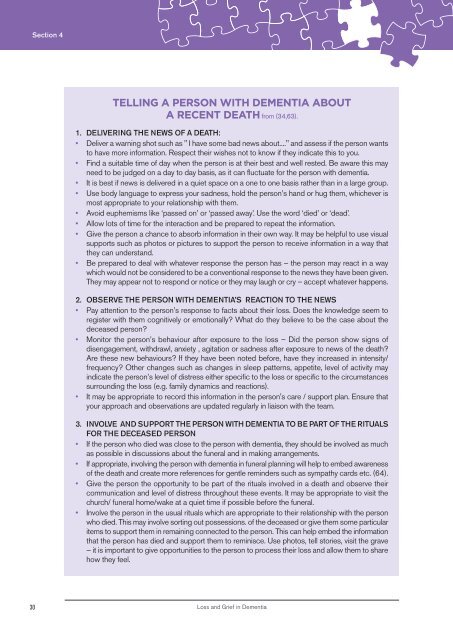Loss and Grief in Dementia
Final-Guidance-Document-3-Loss-Grief
Final-Guidance-Document-3-Loss-Grief
Create successful ePaper yourself
Turn your PDF publications into a flip-book with our unique Google optimized e-Paper software.
Section 4<br />
teLLInG A peRSOn WItH dementIA ABOut<br />
A ReCent deAtH from (34,63).<br />
1. DELIVERING THE NEWS OF A DEATH:<br />
• Deliver a warn<strong>in</strong>g shot such as " I have some bad news about...." <strong>and</strong> assess if the person wants<br />
to have more <strong>in</strong>formation. Respect their wishes not to know if they <strong>in</strong>dicate this to you.<br />
• F<strong>in</strong>d a suitable time of day when the person is at their best <strong>and</strong> well rested. Be aware this may<br />
need to be judged on a day to day basis, as it can fluctuate for the person with dementia.<br />
• It is best if news is delivered <strong>in</strong> a quiet space on a one to one basis rather than <strong>in</strong> a large group.<br />
• Use body language to express your sadness, hold the person’s h<strong>and</strong> or hug them, whichever is<br />
most appropriate to your relationship with them.<br />
• Avoid euphemisms like ‘passed on’ or ‘passed away’. Use the word ‘died’ or ‘dead’.<br />
• Allow lots of time for the <strong>in</strong>teraction <strong>and</strong> be prepared to repeat the <strong>in</strong>formation.<br />
• Give the person a chance to absorb <strong>in</strong>formation <strong>in</strong> their own way. It may be helpful to use visual<br />
supports such as photos or pictures to support the person to receive <strong>in</strong>formation <strong>in</strong> a way that<br />
they can underst<strong>and</strong>.<br />
• Be prepared to deal with whatever response the person has – the person may react <strong>in</strong> a way<br />
which would not be considered to be a conventional response to the news they have been given.<br />
They may appear not to respond or notice or they may laugh or cry – accept whatever happens.<br />
2. OBSERVE THE PERSON WITH DEMENTIA’S REACTION TO THE NEWS<br />
• Pay attention to the person’s response to facts about their loss. Does the knowledge seem to<br />
register with them cognitively or emotionally? What do they believe to be the case about the<br />
deceased person?<br />
• Monitor the person’s behaviour after exposure to the loss – Did the person show signs of<br />
disengagement, withdrawl, anxiety , agitation or sadness after exposure to news of the death?<br />
Are these new behaviours? If they have been noted before, have they <strong>in</strong>creased <strong>in</strong> <strong>in</strong>tensity/<br />
frequency? Other changes such as changes <strong>in</strong> sleep patterns, appetite, level of activity may<br />
<strong>in</strong>dicate the person’s level of distress either specific to the loss or specific to the circumstances<br />
surround<strong>in</strong>g the loss (e.g. family dynamics <strong>and</strong> reactions).<br />
• It may be appropriate to record this <strong>in</strong>formation <strong>in</strong> the person's care / support plan. Ensure that<br />
your approach <strong>and</strong> observations are updated regularly <strong>in</strong> liaison with the team.<br />
3. INVOLVE AND SUPPORT THE PERSON WITH DEMENTIA TO BE PART OF THE RITUALS<br />
FOR THE DECEASED PERSON<br />
• If the person who died was close to the person with dementia, they should be <strong>in</strong>volved as much<br />
as possible <strong>in</strong> discussions about the funeral <strong>and</strong> <strong>in</strong> mak<strong>in</strong>g arrangements.<br />
• If appropriate, <strong>in</strong>volv<strong>in</strong>g the person with dementia <strong>in</strong> funeral plann<strong>in</strong>g will help to embed awareness<br />
of the death <strong>and</strong> create more references for gentle rem<strong>in</strong>ders such as sympathy cards etc. (64).<br />
• Give the person the opportunity to be part of the rituals <strong>in</strong>volved <strong>in</strong> a death <strong>and</strong> observe their<br />
communication <strong>and</strong> level of distress throughout these events. It may be appropriate to visit the<br />
church/ funeral home/wake at a quiet time if possible before the funeral.<br />
• Involve the person <strong>in</strong> the usual rituals which are appropriate to their relationship with the person<br />
who died. This may <strong>in</strong>volve sort<strong>in</strong>g out possessions. of the deceased or give them some particular<br />
items to support them <strong>in</strong> rema<strong>in</strong><strong>in</strong>g connected to the person. This can help embed the <strong>in</strong>formation<br />
that the person has died <strong>and</strong> support them to rem<strong>in</strong>isce. Use photos, tell stories, visit the grave<br />
– it is important to give opportunities to the person to process their loss <strong>and</strong> allow them to share<br />
how they feel.<br />
30<br />
<strong>Loss</strong> <strong>and</strong> <strong>Grief</strong> <strong>in</strong> <strong>Dementia</strong>


